Premium Only Content
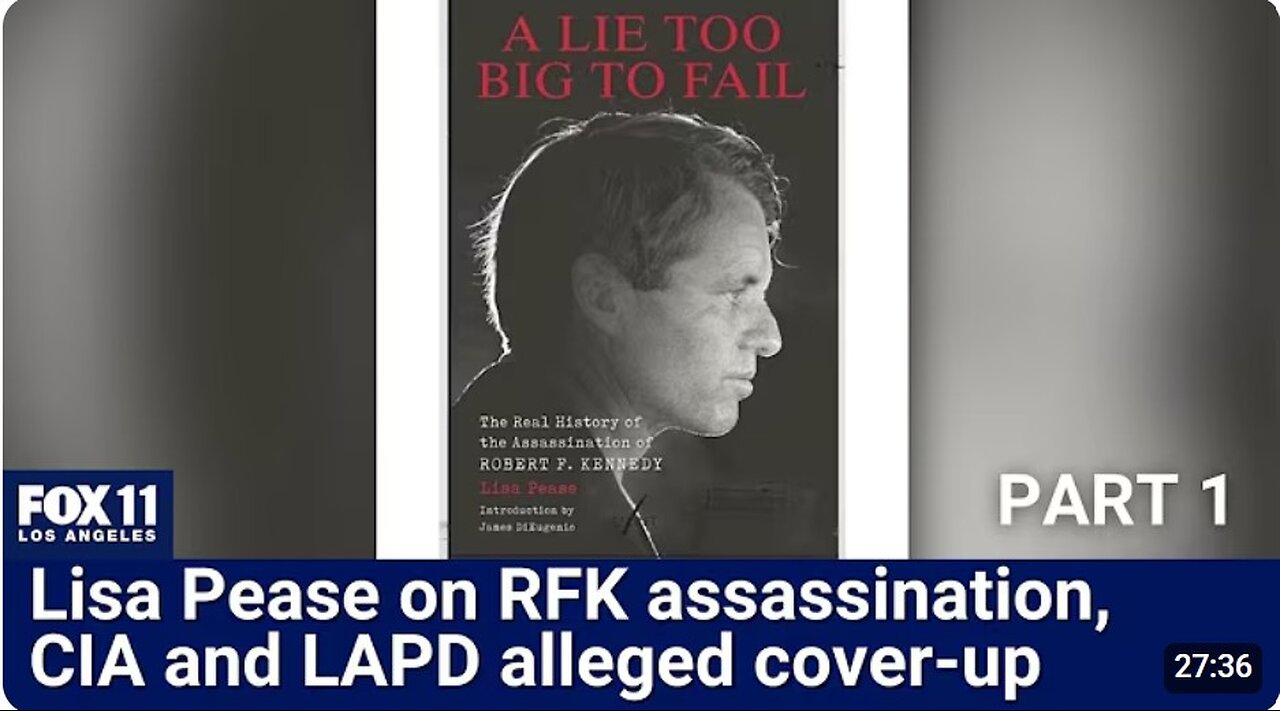
Author Lisa Pease on Robert F. Kennedy assassination, CIA-LAPD alleged cover-up: Part 1 -- 1/19/24
Timestamped summary of the transcript:
• 00:00-00:38 - Educational Background and Early Career - Lisa Pease studied Liberal Arts at the University of Santa Clara and initially pursued a career as an actor, singer, dancer, and harpist for several years before becoming politically engaged through Jerry Brown's gubernatorial campaign.
• 00:38-01:14 - Jerry Brown Campaign Experience - Pease was drawn to Brown's campaign because of its innovative $100 per-person donation limit that prevented special interest influence. She witnessed firsthand how the media fabricated stories and gave airtime to random, non-credible sources instead of actual campaign workers, sparking her interest in media accountability.
• 01:14-01:45 - Media Analysis and Prediction - Through studying reporter bylines and coverage patterns, Pease became skilled at predicting media narratives. After the Oklahoma City bombing, she correctly predicted that reporter Robin Wright would write a pro-CIA article titled "Now We Need the CIA More Than Ever," which served as a diversion during a period when the CIA was under media scrutiny.
• 01:45-02:25 - Discovery of CIA-Media Connections - At a garage sale, Pease purchased Mark Lane's "Plausible Denial," which discussed Priscilla Johnson McMillan, a journalist who wrote about both Oswald's time in the Soviet Union and later authored "Marina and Lee." The revelation that McMillan had CIA ties made Pease realize that CIA involvement in Kennedy's assassination would explain the media's role in covering it up and spreading false alternative theories.
• 02:25-03:01 - Internet Research Begins - When the internet became publicly available, Pease's very first search was "JFK assassination." She discovered Jim Garrison's "On the Trail of the Assassins" and between Lane's and Garrison's books became convinced the CIA killed JFK. She found the newsgroup alt.conspiracy.JFK where the case was being debated.
• 03:01-03:33 - Online Debate Participation - Pease was shocked by the rudeness in online forums, particularly one man who aggressively attacked people posting evidence of conspiracy. She joined the discussions to defend truth-seekers and began conducting library research to counter his arguments with documented evidence.
• 03:33-04:07 - Warren Commission Discovery - At the library, Pease found a complete set of Warren Commission volumes. She randomly pulled out one volume containing Dr. Malcolm Perry's testimony. Perry was the doctor who treated JFK immediately after the shooting and had pointed to an entrance wound in Kennedy's throat during a press conference.
• 04:07-04:40 - Arlen Specter's Manipulation - Pease discovered that Senator Arlen Specter questioned Dr. Perry in a way that made it obvious Perry knew the throat wound was an entrance wound, but Specter constructed elaborate hypotheticals ("if the bullet wasn't moving that fast, if it tumbled a certain way") to get Perry to say it could possibly be an exit wound under extreme circumstances.
• 04:40-05:14 - Media Truth Becomes History - Perry's qualified statement under hypothetical conditions became "the truth" that media reported, without journalists reviewing his actual testimony. Pease learned that reporters lack time and budget to investigate deeply, so initial five-minute reports from Dallas or Bethesda become locked in as historical fact, even when contradicted by later evidence.
• 05:14-05:48 - Expertise and Documentary Work - After 30 years of research, Pease became recognized as one of the leading experts on assassination cases and was involved in Oliver Stone's documentary on the subject, helping to present evidence that mainstream media typically ignores.
• 05:48-06:27 - Dag Hammarskjöld Case - Pease expanded research beyond JFK and RFK to include UN Secretary General Dag Hammarskjöld, whose plane was allegedly shot down (with bullet holes throughout the fuselage proving assassination rather than accident). She testified before a UN commission reinvestigating the case, connecting it to conflicts in the Congo.
• 06:27-06:59 - Congo Massacre and Resource Wars - Hammarskjöld stood up for Congolese people who continue to suffer massacres today as a direct result of 1960s events. The Congo sits on extremely valuable rare earth minerals (more valuable than oil and gas) needed for cell phones, cars, planes, and computers, making the population targets for resource theft.
• 06:59-07:33 - War and Resources Theory - Through her research, Pease concluded that every war has been about resources, not religion or ideology (which serve as excuses). She cites Gaza as an example, where an offshore oil and gas field belonging to Gaza and valuable beachfront property motivate conflict.
• 07:33-08:10 - Law School Decision - After the Brown campaign, Pease was accepted to law school with encouragement to apply for a full scholarship. She wanted to be a public interest lawyer but questioned whether the expensive, long road was right for her, especially as she became increasingly interested in assassination research.
• 08:10-08:39 - Choosing Research Over Law - Pease realized there were many lawyers but few serious researchers willing to sift through thousands of documents rather than engage in "wild conspiracy theorizing." She spent lunch hours at the library searching for books and working through documents, making research her daily practice.
• 08:39-09:08 - Career Path Decision - After asking every lawyer she knew about their work, they all said "you're going to love school and hate the practice." Pease decided she loved research too much and felt called to pursue truth, even though she wouldn't make money at it like she would have as a lawyer.
• 09:08-09:50 - Realizing Present-Day Relevance - What hooked Pease on JFK assassination research was realizing it mattered in the present, not just the past. The vehemence with which some people defended the official position seemed bizarre—why would an official position need defending unless something was being hidden?
• 09:50-10:23 - Investigating Forum Participants - Pease became curious about people posting in the forum and started researching their backgrounds. One particularly aggressive defender was a Harvard-trained PhD working at a university. Pease called Harvard to confirm his credentials because his arguments were so poor.
• 10:23-10:58 - CIA Connection Revealed - Pease tried to find CIA links to the Harvard PhD but couldn't initially. Then he accidentally outed himself by posting that he was an official representative to an institute that Pease knew was founded entirely with CIA money. After she called this out, he went silent for two weeks.
• 10:58-11:30 - CIA Strategy Exposed - Pease figured he went to Langley for instructions and was likely told to ignore the revelation because "no one will remember, people forget, no one will believe it anyway"—which is essentially what happened. He resumed posting as if nothing occurred, demonstrating CIA tactics for managing exposure.
• 11:30-12:04 - Media Acknowledgment of Cover-up - Even mainstream media acknowledged the cover-up in recent years. When Biden refused to release remaining JFK files, even Morning Joe did a segment questioning whether withholding sensitive information 60 years later was essentially an admission of CIA guilt.
• 12:04-13:15 - Media Corruption and Iraq War - Pease's research was fundamentally about media corruption in concealing important truths. She witnessed the weapons of mass destruction lie that led to war in Iraq, killing a million innocent people over non-existent weapons. She believes exposing truth can wake people up and change the world.
• 13:15-13:48 - Discovering the Real JFK - As Pease researched the assassination, she learned who John Kennedy really was, discovering that almost everything commonly believed about him—being a womanizer, the mob stealing his election—was completely untrue. Most womanizing stories were provably fabricated, with characters literally invented.
• 13:48-14:22 - Judith Exner and Government Manipulation - Judith Exner, who accused JFK of an affair, stated in an interview "the government wants me to talk again," revealing government prodding to spread stories. Pease saw a tabloid with Priscilla Johnson McMillan claiming she slept with JFK, which seemed implausible and politically motivated.
• 14:22-14:57 - McMillan as CIA Asset - In CIA files, Priscilla Johnson McMillan is listed as a "witting asset" (someone who knowingly works for the CIA), unlike "unwitting assets" who are manipulated without knowing it. If she published stories claiming intimacy with JFK, it was because the CIA directed her to do so.
• 14:57-15:33 - RFK Funeral Memory - As a child, Pease vividly remembered Robert F. Kennedy's funeral and the long funeral train from New York to Arlington (not Boston as she initially misstated). She saw people with signs saying "Goodbye Bobby," "Bobby we hardly knew ye," and "We love you Bobby," feeling even as a child that the best politician of her lifetime had died.
• 15:33-16:14 - RFK Investigation Motivation - After becoming convinced the CIA killed JFK, Pease wondered what happened to Bobby. While she had read books about RFK's assassination, she wanted to examine primary evidence and original witness statements rather than rely on secondary sources.
• 16:14-16:48 - LAPD Files Discovery - During a lunch hour library visit in 1993, Pease accidentally pulled out the wrong microfilm drawer while searching for FBI files on JFK. She discovered all the LAPD files on the RFK assassination on microfilm at the Central Library downtown, which had only been released to the public in 1988—just five years earlier.
• 16:48-17:23 - Second Suspect Found - The first reel Pease examined revealed a second person arrested at the Ambassador Hotel that night—apprehended, handcuffed, photographed, held for questioning all night, and not released until morning. The FBI agent's report noted the suspect "didn't seem upset that he'd been held overnight," which Pease found significant.
• 17:23-18:00 - Multiple Suspects and Shooter on Table - Pease discovered there were multiple suspects beyond Sirhan Sirhan, contradicting the official narrative that everyone saw only Sirhan fire. Four witnesses, including George Green (whose testimony is available online), saw a shooter standing on the table firing downward. Sirhan was never on top of the table shooting—he was pushed onto it later.
• 18:00-18:36 - Terry Lee Fraser Arrest - Another person arrested that night was Terry Lee Fraser, a young blonde man found "skulking around in the bushes" outside the Ambassador Hotel after the assassination. When police questioned him, he claimed he was looking for friends who seemed to have left, but his story made no sense.
• 18:36-19:10 - Fraser Released Despite Inconsistencies - Despite Fraser's suspicious behavior and nonsensical story that would suggest conspiracy, police simply ignored him and let him go. This pattern of dismissing evidence of additional suspects was consistent with the LAPD's handling of the case.
• 19:10-19:44 - Four Additional Bullet Holes - In the pantry where Kennedy was shot, sheriffs who arrived before LAPD found bullet holes in the doorframe. Two bullet holes were in the center frame (vertical), and two were in the southern side of the doorframe (almost horizontal)—four bullet holes that were circled, labeled, and initialed by investigators.
• 19:44-20:19 - Standard Evidence Procedures Prove Extra Bullets - Circling, labeling, and initialing holes is standard operating procedure only when bullets are removed, not for pin pricks or pencil stabs. This proves four bullets were removed from the doorframe, even though Sirhan's gun only held eight bullets total, and five people besides Kennedy were wounded.
• 20:19-20:57 - Kennedy's Wounds from Behind - Kennedy was shot four times: three times under his right arm and once behind his right ear, all from behind at close range (within 1.5 inches based on powder burns). All wounds were back-to-front direction, none were front-to-back, yet all witnesses placed Sirhan in front of Kennedy.
• 20:57-21:34 - Witness Testimony Analysis - Pease created a spreadsheet analyzing all 70 witnesses listed in the pantry. Most didn't see Sirhan at all. Only about five could 100% identify Sirhan as the shooter, and every one of them placed Sirhan in front of Kennedy, facing him. None saw Kennedy spin around or Sirhan lunge forward to shoot from behind.
• 21:34-22:11 - Kennedy's Defensive Response - Witnesses who saw both Kennedy and Sirhan observed Kennedy throw his hands up in front of his face in response to the perceived threat from the front, then fall backward already shot. If Sirhan fired real bullets, his first shot would have hit Kennedy's chest in a wide-open shot, but there are no frontal wounds.
• 22:11-22:42 - Sirhan Fired Blanks Theory - Based on evidence that people behind Kennedy were wounded (suggesting someone firing from Sirhan's position) but Kennedy had no frontal wounds, Pease concluded Sirhan was firing blanks. She acknowledges this complicated story is hard to explain in interviews, which is why she wrote a book with full documentation.
• 22:42-23:16 - Missing Ballistics Comparison - In LAPD files, there is no record that criminalist Dwayne Wolfer compared the bullet retrieved from Kennedy's neck to a test bullet fired from Sirhan's gun under a microscope. The reason: he could tell by visual inspection they didn't match—one had two grooves, one had one groove, with obvious physical differences.
• 23:16-23:52 - Fabricated Photo Micrograph - LAPD files show that the night after receiving Kennedy's autopsy bullet, Wolfer spent five hours in the lab creating a photo micrograph of two bullets that came from neither Kennedy nor Sirhan's gun. He fabricated evidence to falsely show a match between Sirhan's gun and Kennedy's wound.
• 23:52-24:30 - Secret Evidence with Known Problems - When Congressman Allard Lowenstein investigated in 1975, Wolfer or the LAPD revealed they had a "secret photo micrograph" to prove Sirhan shot Kennedy, but admitted "a discerning buff might find a problem with it" so they didn't want to release it publicly. They planned to use this fabricated evidence only if the case went to trial.
• 24:30-25:01 - The Second Gun Film and Thane Eugene Cesar - By 1975, evidence of extra bullets led to creation of a panel to investigate. Ted Charach's film "The Second Gun" claimed security guard Thane Eugene Cesar, positioned at Kennedy's right elbow, probably shot him. A witness claimed to see the guard fire. Pease discovered Caesar had provable ties to the CIA.
• 25:01-25:39 - CIA Records FOIA and Cover-up - A San Francisco lawyer filed a FOIA request for Thane Eugene Caesar's CIA records and was denied "on operational grounds"—essentially confirmation of CIA connection. Realizing their mistake, when the lawyer filed again, the CIA claimed "we found no records responsive to FOIA," attempting to backpedal from their initial admission.
• 25:39-26:13 - Public Records Database Confirmation - Pease searched three separate public records databases (commonly used by media to find addresses and employment information from voter registration and campaign donations). All three databases returned the same result: Thane Eugene Caesar was listed as a "CIA contract agent" with no other profession listed anywhere in his records.
• 26:13-26:50 - Caesar's CIA-Linked Addresses - The public records databases showed Caesar's addresses included Langley (CIA headquarters), the Mormon Church (which has long-standing ties to the CIA), and General Motors. At the time, GM's CEO was a woman who had worked for the CIA, providing another connection to the intelligence agency.
• 26:50-27:27 - Robert Maheu Connection and Mob Ties - Caesar had connections to Robert Maheu, whom the CIA hired to bring the mob into Castro assassination plots. Maheu was a mob-connected figure, and Caesar appeared to have mob ties as well, creating a network connecting the CIA, organized crime, and Kennedy's assassination. Pease met John Meyer, a Canadian who worked in the same office as Maheu for Howard Hughes (unlike Maheu, Meyer actually met Hughes in person, as Hughes avoided Maheu).
____________________________
Original Source Attribution:
'Author Lisa Pease on Robert F. Kennedy assassination, CIA-LAPD alleged cover-up: Part 1' | FOX 11 Los Angeles | Jan 19, 2024 | https://youtu.be/ZZbvDgBpV00?si=hWJ20PB9G6OholA5
Researcher and author Lisa Pease discusses her work, "A Lie Too Big to Fail: The Real History of the Assassination of Robert F. Kennedy."
WATCH PART 2: https://youtu.be/aisW_pWgk4I?si=a4ynhvby3_p28W91
WATCH PART 3: https://youtu.be/3oEZSRDIkGs?si=4_k5jWOrqL052tSJ
___________________________
*** COPYRIGHT DISCLAIMER: This video and channel content are for educational purposes and use copyrighted material (clips) under the Fair Use Doctrine (Title 17 U.S.C. Section 107). This channel IS NOT MONETIZED, and all content is used for commentary, criticism, news reporting, or educational purposes, and falls within the guidelines of fair use. No copyright infringement is intended. All rights to the original content belong to the respective copyright holders. If you wish to have your content removed, please email us through your channel's email address, or contact me directly at [email protected]. ***
-
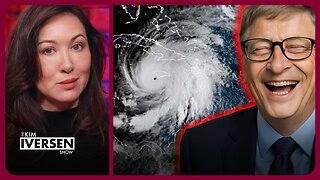 1:12:57
1:12:57
Kim Iversen
5 hours agoBill Gates Suddenly Says “Don’t Worry About Climate Change”?
73.2K46 -
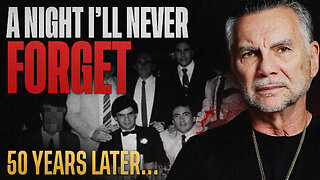 1:05:12
1:05:12
Michael Franzese
5 hours agoI Waited 50 Years to Tell You What Happened on Halloween 1975
29.3K10 -
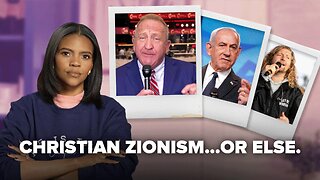 1:07:15
1:07:15
Candace Show Podcast
5 hours agoINFILTRATION: Charlie Kirk Was Being Tracked For Years. | Candace Ep 256
71.7K246 -
 LIVE
LIVE
Rallied
4 hours ago $1.80 earnedWarzone Solo Challenges then RedSec Domination
178 watching -
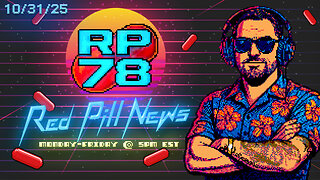 2:34:30
2:34:30
Red Pill News
7 hours agoBoomerang Time - DOJ Investigating BLM Fraud on Red Pill News Live
59.6K12 -
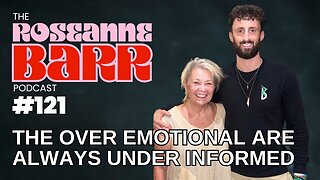 1:46:14
1:46:14
Roseanne Barr
7 hours ago“The Over Emotional Are Always Under Informed” | The Roseanne Barr Podcast #121
89.7K55 -
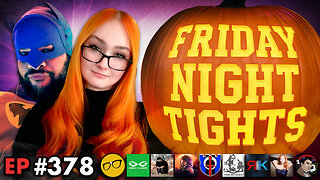 3:24:28
3:24:28
Nerdrotic
8 hours ago $11.69 earnedThe WitcHER DOA | Box Office Massacre | Massive Industry Layoffs - Friday Night Tights 378
52.8K8 -
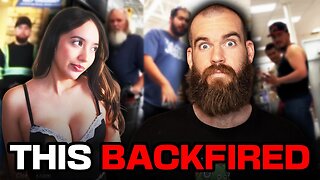 14:54
14:54
IsaacButterfield
16 hours ago $4.51 earnedShe Called Out “Creepy Men It Didn’t End Well
28.1K51 -
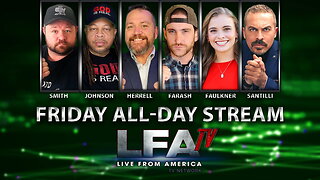 11:43:21
11:43:21
LFA TV
1 day agoLIVE & BREAKING NEWS! | FRIDAY 10/31/25
193K47 -
 1:08:42
1:08:42
vivafrei
7 hours agoEric Swalwell in Trouble Again? RFK Jr. "Reverses Course" on Tylenol & Autism? Arctic Frost & MORE!
86.2K40